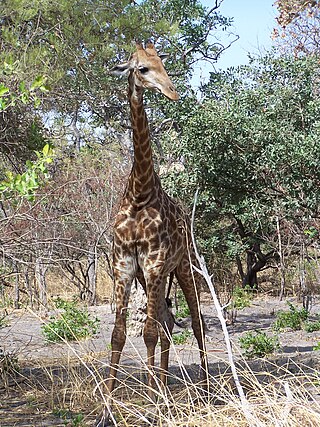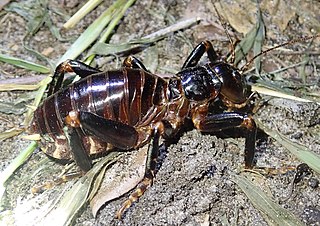
The Araliaceae are a family of flowering plants composed of about 43 genera and around 1500 species consisting of primarily woody plants and some herbaceous plants. The morphology of Araliaceae varies widely, but it is predominantly distinguishable based on its woody habit, tropical distribution, and the presence of simple umbels.

The Virginia Range is a mountain range of western Nevada, primarily within Storey County, and extending east into Lyon County. The range is named after James Finney, "Old Virginny", an early discoverer of gold associated with the Comstock Lode.
Stenopelmatus is one of two genera of large, flightless insects referred to commonly as Jerusalem crickets. They are primarily native to Central America, and one species is known from Ecuador.

The family Stenopelmatidae is composed of large, mostly flightless insects resembling crickets. Two genera: Ammopelmatus and the type genus Stenopelmatus are found in the New World. Oryctopus and Sia are Old World genera, and previously placed in their own subfamilies, but with the addition of new genera, current placement is as five tribes in the single subfamily Stenopelmatinae.

A conservation-dependent species is a species which has been categorized as "Conservation Dependent" ("LR/cd") by the International Union for Conservation of Nature (IUCN), as dependent on conservation efforts to prevent it from becoming endangered. A species that is reliant on the conservation attempts of humans is considered conservation dependent. Such species must be the focus of a continuing species-specific and/or habitat-specific conservation program, the cessation of which would result in the species qualifying for one of the threatened categories within a period of five years. The determination of status is constantly monitored and can change.

Translocation in wildlife conservation is the capture, transport and release or introduction of species, habitats or other ecological material from one location to another. It contrasts with reintroduction, a term which is generally used to denote the introduction into the wild of species from captive stock. The International Union for the Conservation of Nature (IUCN) catalogues translocation projects for threatened species around the globe.
The Visayan babbler, formerly conspecific with the Calabarzon babbler, is a species of bird in the family Zosteropidae. It is endemic to the Philippines. It is found on Samar, Leyte and Bohol.

Ammopelmatus is a genus of insects in the family Stenopelmatidae, one of two genera of large, flightless insects referred to commonly as Jerusalem crickets. They are native to western United States and northwestern Mexico.

Ammopelmatus muwu is a species of insect in family Stenopelmatidae. It is endemic to parts of San Luis Obisbo and Santa Barbara counties in United States state of California.
Ammopelmatus cahuilaensis is a species of insect in the family Stenopelmatidae. The species is found in the Coachella Valley and was described by Ernest R. Tinkham in 1968, in The Great Basin Naturalist.
Ammopelmatus navajo, commonly known as the Navajo Jerusalem cricket, is a species of nocturnal Jerusalem cricket in the family Stenopelmatidae. It is endemic to the United States, specifically Arizona, and found under rocks in loose soil. It is closely related to A. fuscus and they have nearly identical drumming patterns. They live one to two years as adults, but can die prematurely by parasitic infections, commonly by the horsehair worm.

Sterrhoptilus is a songbird genus recently separated from Stachyris. It used to be placed in the family Timaliidae. With other "Old World babblers" of the genus Yuhina, it was recently determined to be better placed in the family Zosteropidae.

Jerusalem crickets are a group of large, flightless insects in the genera Ammopelmatus and Stenopelmatus, together comprising the tribe Stenopelmatini. The former genus is native to the western United States and parts of Mexico, while the latter genus is from Central America.
As of July 2016, the International Union for Conservation of Nature (IUCN) lists 238 conservation dependent species. 0.29% of all evaluated species are listed as conservation dependent. The IUCN also lists seven subspecies and five varieties as conservation dependent.

Uxbridge Moor is a nature reserve managed by the London Wildlife Trust in Uxbridge in the London Borough of Hillingdon. It is a Site of Metropolitan Importance for Nature Conservation.
Ammopelmatus pictus is a species of Jerusalem cricket in the family Stenopelmatidae. It is found in parts of the Central Valley, Diablo Range, and Silicon Valley within California.
Ammopelmatus mescaleroensis is a species of Jerusalem cricket in the family Stenopelmatidae. It is found in the area around Mescalero, in the United States state of New Mexico.

Stenopelmatinae is the sole subfamily in the family Stenopelmatidae. There are about 7 genera and more than 50 described species in Stenopelmatinae.
Ammopelmatus longispina is a species of Jerusalem cricket in the family Stenopelmatidae. It is found in North America.
Black-crowned babbler has been split into two species:
This page is based on this
Wikipedia article Text is available under the
CC BY-SA 4.0 license; additional terms may apply.
Images, videos and audio are available under their respective licenses.










